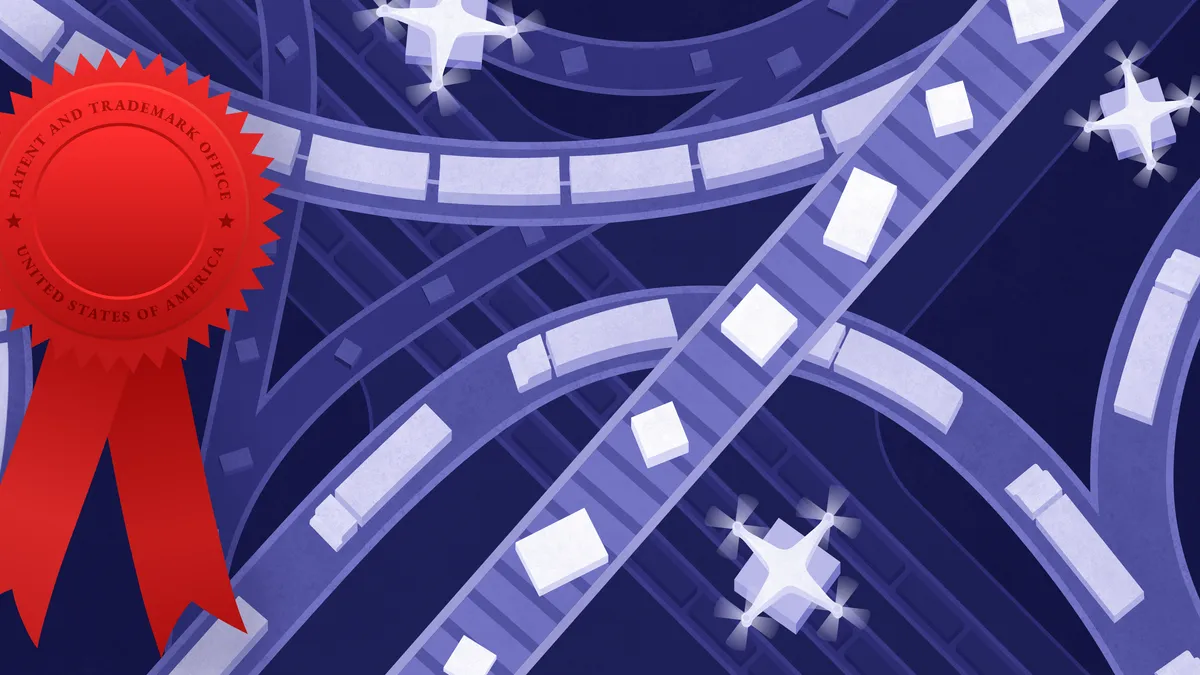This is Patent Pending. Supply chain-related patent applications are published every week and this is where we'll talk about the ones that could have the biggest impact on the supply chain and the ones that challenge the norm. We want to give you an idea of where supply chains are heading and what the industry is thinking. Keep an eye out for this column on Fridays. Read last week's here.
We learn from our mistakes ... so will robots
Facilities managers often add robotic systems to fulfillment centers with the goal of reducing labor cost and increasing efficiency. But, efficient machines aren't perfect.
Robots can fail at picking up an object or moving in the correct manner, and even the same model of robot can perform the same job slightly differently based on how it is tuned, Amazon points out in a patent application published this week.
Amazon's plan includes a control system that monitors operations of robots. It will notice when robots fail and use machine learning models and sensor data to tune the robots. It will be able to determine what action the robot was performing, what movement it was making at the time of failure and what item it was carrying when it failed.
The robots in the fulfillment system are controlled by a management module. It can task the robots to pick specific inventory or move containers. But it can also act as this control system laid out in the patent application. One example it lays out is lighting change within the fulfillment center.
- Sensors in the building pick up a change in lighting. This can affect the way computer vision systems, used to control robotic devices, view items.
- This information is relayed to the management module where the algorithm will determine what changes to make to the robotic controls.
- The module will make the needed change. In this case, it would be an image filter or a change to the camera settings like focal length or exposure.
The system can tweak itself based on the outcome. It will be more likely to provide this change if it provides the desired effect and less likely to do so if it doesn't work.
Read up:
Knowing whether the weather works in your favor
There is no shortage of items that have to be kept at the right temperature during transport: Life-saving medication, Alaskan salmon, avocados from California. When carriers agree to carry such items it means taking extra precautions. In a patent application published this week, UPS explains costly measures are often taken to ensure items stay within the correct temperature range. This might include special packaging or refrigerated transport. But the logistics company says costs could be avoided if there was reliable information on the weather along their route.
The system UPS describes:
- A route-based weather monitoring system pulls in weather information from a variety of sources.
- A user inputs the desired route.
- A system pulls weather information for multiple locations along the route and provides a weather report specific to this destination.
This processes is typically done manually and can be inaccurate, UPS said.
The weather information would come from weather stations along the route on highways or at sortation centers. After providing the weather along the route, the same system would be able to provide shipping options, letting the user know if it will remain within the desired temperature range without intervention or if a temperature-controlled vehicle will be needed.
Read up:
-
Online grocery could increase cold storage demand by 100M square feet
-
Technology permeates the cold chain warehouse — but it has its limits
Robotic fulfillment for public pickup
Post offices, like any logistics hub in the e-commerce era, has seen an influx of parcels from online orders.
Orders come in a variety of sizes and in an increasing volume. A patent application published this week by three researchers examines how to bring the principals of warehousing to the consumer-facing warehouse: namely the separation of sortation and fulfillment and the use of robots to increase automation.
The problem with the current layout of a post office, the application said, is it doesn't use space efficiently. It only allows for items to be stored for pickup in the customer-facing lockers. But the backroom could also be used for storage. This system would use a robot to transfer items between the backroom and the customer's locker.
The robotic system would be able to determine what locker to pace orders in using RFID that is affixed to each locker.
This robotic post office could provide updates and status notifications to customers.















